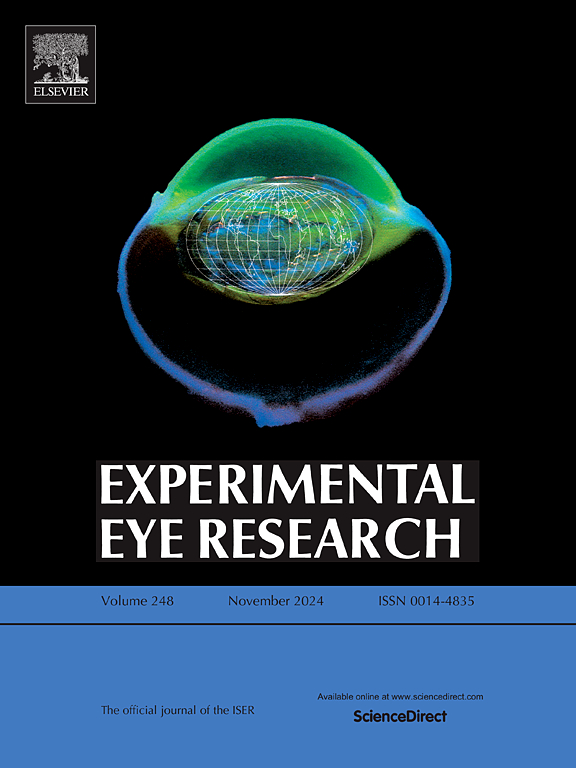Analysis of the sclera elasticity properties and comparison with corneal biomechanics properties in vivo and in vitro
IF 3
2区 医学
Q1 OPHTHALMOLOGY
引用次数: 0
Abstract
Purpose
To explore scleral elastic modulus and its correlation with corneal biomechanics in vivo and in vitro, and to introduce a predictive model for non-destructive characterization of scleral and corneal elastic modulus.
Methods
In vivo biomechanical parameters of 21 rabbit eyes were measured using the Corvis ST. Uniaxial tensile tests on corneal and scleral (anterior, equatorial, and posterior sections) strips provided low-strain and high-strain tangent elastic modulus (LSTM and HSTM). Pearson's and Spearman's correlation analyses were used to examine the relationship. A multivariate linear regression model was used to characterize the elastic modulus in vivo. Transmission electron microscopy was used to elucidate the arrangement of collagen fibers in the anterior, equatorial, and posterior sclera.
Results
Twelve in vivo parameters significantly correlate with the corneal LSTM (P < 0.05), whereas no parameters are correlated with the corneal HSTM. SP-HC (Rho = 0.442) and HC Deflection Amp (HC DA, r = −0.605) correlated with anterior sclera LSTM. DA ratio 1 mm (r = 0.446) was correlated with the equatorial sclera LSTM. Integrated Radius (Rho = 0.483) and Radius (r = −0.473) were correlated with the equatorial sclera HSTM. The representative multivariate linear regression model indicated the follows:
Corneal LSTM = 0.046 + 0.01 ∗ SP-A1 + 0.066 ∗ SSI.
Anterior sclera LSTM = 0.294–0.120 ∗ HC DA.
Equatorial sclera LSTM = 0.22 + 0.114 ∗ DA Ratio 1 mm - 0.049 ∗ HC DA.
Conclusions
Biomechanical parameters, such as SP-A1 and SSI, correlate with the low-strain elasticity of the cornea, which primarily reflects the properties of the corneal ground matrix. Corvis ST may not be able to detect biomechanics changes in the cornea collagen structure. The scleral elastic modulus prediction model offers new insights into the non-destructive characterization of scleral biomechanics.
分析巩膜弹性特性并与角膜生物力学特性进行体内和体外比较
目的探讨巩膜弹性模量及其与体内、体外角膜生物力学的相关性,建立巩膜和角膜弹性模量无损表征的预测模型。方法采用Corvis st法测定21只兔眼的体内生物力学参数,采用低应变和高应变切线弹性模量(LSTM和HSTM)的角膜和巩膜(前、赤道和后切片)条进行单轴拉伸试验。使用Pearson’s和Spearman’s相关分析来检验两者之间的关系。采用多元线性回归模型对体内弹性模量进行表征。透射电镜观察胶原纤维在巩膜前部、赤道部和后部的排列。结果12个体内参数与角膜LSTM有显著相关性(P <;0.05),而没有参数与角膜HSTM相关。SP-HC (Rho = 0.442)和HC挠曲Amp (HC DA, r = - 0.605)与前巩膜LSTM相关。DA比值1 mm与赤道巩膜LSTM相关(r = 0.446)。积分半径(Rho = 0.483)和半径(r =−0.473)与赤道巩膜HSTM相关。具有代表性的多元线性回归模型为:角膜LSTM = 0.046 + 0.01 * SP-A1 + 0.066 * SSI。前巩膜LSTM = 0.294-0.120 * HC DA。赤道巩膜LSTM = 0.22 + 0.114 * DA比值1 mm - 0.049 * HC DA。结论SP-A1、SSI等生物力学参数与角膜的低应变弹性相关,主要反映角膜基质的性质。Corvis ST可能无法检测角膜胶原结构的生物力学变化。巩膜弹性模量预测模型为巩膜生物力学的无损表征提供了新的见解。
本文章由计算机程序翻译,如有差异,请以英文原文为准。
求助全文
约1分钟内获得全文
求助全文
来源期刊

Experimental eye research
医学-眼科学
CiteScore
6.80
自引率
5.90%
发文量
323
审稿时长
66 days
期刊介绍:
The primary goal of Experimental Eye Research is to publish original research papers on all aspects of experimental biology of the eye and ocular tissues that seek to define the mechanisms of normal function and/or disease. Studies of ocular tissues that encompass the disciplines of cell biology, developmental biology, genetics, molecular biology, physiology, biochemistry, biophysics, immunology or microbiology are most welcomed. Manuscripts that are purely clinical or in a surgical area of ophthalmology are not appropriate for submission to Experimental Eye Research and if received will be returned without review.
 求助内容:
求助内容: 应助结果提醒方式:
应助结果提醒方式:


